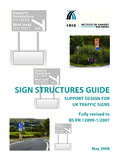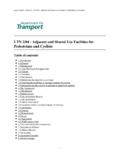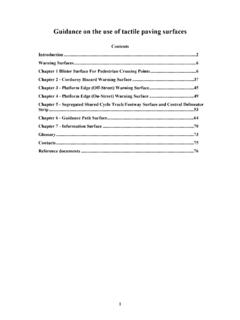Transcription of Highways (Road Humps) Regulations 1996 - UK Roads Ltd
1 Traffic Advisory Leaflet 7/96 June 1996 Highways ( road humps ) Regulations 1996 Introduction Since the Highways ( road humps ) Regulations 1990 were introduced, considerable research has been carried out into the performance of road humps . This has paid particular attention to those types of humps which did not conform to the 1990 Regulations , such as speed cushions, and narrow thermoplastic humps known as "thumps". The results of this work have helped indicate that the very prescriptive nature of the 1990 Regulations was unnecessary. As a result, the 1990 Regulations have been replaced by the very much simplified Highways ( road humps ) Regulation 1996 , leaving the actual design and location of road humps a matter for local highway authorities to determine. Since the road humps (Scotland) Regulations remain unchanged, the contents of this leaflet are not generally applicable to Scotland.
2 The advice in Traffic Advisory leaflet 3/91 remains current. The primary legislation is the Highways Act 1980, sections 90A to 90F, and this remains unchanged. It makes it clear that road humps can only be constructed on Roads which have a speed limit of 30mph or less (sections 90A and 90B); contains requirements to advertise and consult the police (sections 90C); and contains the assurance that road humps constructed in accordance with Regulations , or specially authorised, or constructed prior to adoption of the highway , are not treated as obstructions (section 90E). The new Regulations provide local highway authorities with considerable flexibility in the design and placement of road humps . However, the Regulations make local highway authorities responsible for the design and placement, so authorities will need to ensure that an adequate duty of care is exercised. Purpose The purpose of this leaflet is to provide general advice on the use of road humps under the Highways ( road humps ) Regulations 1996 .
3 It does not attempt to cover every eventuality, and it is for local highway authorities to ensure that designs do not compromise safety. Previous technical advice issued on road humps is still generally relevant. With the exception of Traffic Advisory Leaflet 2/90 and 3/91 (which contained advice on the previous road Hump Regulations ), information contained in this leaflet is intended to enlarge on, rather than replace, previous advice. This guidance should be read in conjunction with the Highways ( road humps ) Regulations 1996 themselves. rumble Devices The use of rumble strips and rumble areas is enabled by the Highways Act 1980 (as amended by the Traffic Calming Act 1992), and the Highways (Traffic Calming) Regulations 1993. Advice is contained in TA Leaflet 11/93. The maximum height permitted under the Traffic calming Regulations for a rumble device is 15mm. Technically, rumble devices with heights larger than this could be specially authorised, but it is likely that in most cases the requirements of the road hump legislation would have effect.
4 Special authorisations With the simplification of the Regulations there should be very little need for road humps to be specially authorised. An exception would be where a road hump was of a design where its height could be varied mechanically. Special authorisation would also be needed for a hump higher than 100mm or lower than 25mm, though a very detailed supporting case would need to be put forward for any proposal where the road hump exceeded 100mm in height. Consultation The requirement in the highway Act 1980 (Section 90C) to consult with the police and to advertise proposed road hump schemes still applies. In addition, the new Regulations require the fire and ambulance services to be consulted, as well as organisations or groups representing people who use the road . This should certainly include bus operators, and residents of the street where the road humps are to be installed.
5 Bus operators need to be consulted not only about Roads which have bus routes, but also on adjacent Roads , so that the operators are aware should the need for bus diversions arise. Also, depending on the type of road and the area, it may be appropriate to seek the views of agricultural and haulage interests. It is recommended that the consultation process is not limited just to carrying out the statutory duties, but should open up a dialogue with all interested parties to ensure that as far as possible there is a consensus in favour of the scheme. At times it may be necessary for the highway authority to demonstrate their willingness to modify schemes in order to obtain an acceptable compromise. The Fire and Ambulance services will be concerned about response times; the advice in Traffic Advisory Leaflet 3/94 is still relevant. road Hump Dimensions The only dimensions now constrained by the Regulations are: maximum and minimum heights of 100mm and 25mm respectively; a minimum length of 900mm; and no vertical face to exceed 6mm in height.
6 It should be noted that the tolerances included in the 1990 road Hump Regulations do not apply to the new Regulations . So exceeding the 100mm height, without authorisation. So exceeding the 100mm height, without authorisation, would be likely to mean that Section 90E of Highways Act 1980 did not apply, with the result that the road hump could be viewed as an obstruction. ( humps constructed prior to the 1996 Regulations will not be affected by this). Additionally it is not considered good practice to deliberately choose heights which are either higher or lower than those prescribed, on the grounds that the Regulations would not then apply. This again would mean that Section 90E of the Highways Act would not apply with consequences for the highway authority in providing the device was not an obstruction. Heights It will be appropriate to vary the height of the hump, in accordance with: circumstances of the location ( strategic route or residential); speed reduction required (mean "between hump" speeds of about 30mph, or 20mph); and the type of the road hump feature.
7 Table 1 indicates general height dimensions for road types in accordance with approximate "between humps " mean speeds. Spacing between humps will also affect speed between humps : the lower the height the smaller the spacing to achieve suitable speed reductions. Ramp gradients may also influence mean "between hump" speeds. "Thumps" in excess of 50mm high may cause considerable discomfort to vehicle occupants and are not recommended. Kerb to kerb flat top humps , of whatever type, cannot generally be laid to footway level without the kerbs being "dropped". Standard kerb heights between 125mm to 150mm high would exceed the prescribed 100mm height for road humps . Longitudinal profile Hump profiles will generally be either curved, or flat top with ramps. Combinations of both curved and flat top road humps have been used but little design or performance information is available on them, so care should be taken if adopting such designs.
8 The profile of curved ramps in the UK has generally been a segment of a circle. In other countries different shapes, such as sinusoidal curves have been used. The new Regulations will allow such curves, but caution should be exercised as these may be difficult to form, and hence expensive. Information on the performance of sinusoidal humps , or similar is available based on research carried out abroad, however, this may not be entirely applicable to conditions in this country. Transverse profile The new Regulations allow freedom for the designer to decide on the type of transverse profile adopted. However, it is recommended that generally the profile chosen follows previous advice. In the case of tapered humps , other than as described below, the channel should not be greater than 200mm in width and the width of the side ramps should be between 150mm to 300mm. It has been advocated that the width of the side ramp should be increased to allow an easier ride for cyclists.
9 However, where there are cyclists present it would seem preferable to increase the channel width to create a cycle lane. "Thumps" should normally finish within 200mm of the kerb to assist drainage. Where cyclists are likely to be present it may be an advantage to increase the gap, up to 750mm. For speed cushions, the gap between the foot of the side ramp and the adjacent kerb should normally be not less than 750mm, to allow two wheeled vehicles (cycles and motorcycles) to avoid the cushions. This may be decreased if the nearside cushion (particularly in a three in line arrangement) is continually parked over, but in that event 500mm should be regarded as the minimum. The gap between adjacent cushions laid transversely in line, as measured between the foot of the respective ramps, should also normally be not less than 750mm. Smaller gaps have been used, but this may cause problems for two wheel vehicles, and makes it difficult for bus drivers in aligning their vehicles to straddle the cushions.
10 Widths less than 500mm are not recommended, and should only be adopted in extreme situations. Maximum widths between cushions, or a cushion and a kerb, should not normally be greater than 1200mm, with 1000mm an ideal maximum. Widths greater than this will encourage drivers to aim for the gaps, which can cause concern to other drivers if it occurs in the centre of the carriageway, and to pedestrians if it is adjacent to the footway. Ramp gradients To limit the effects of vehicles grounding, it is recommended that the on/off gradients of road humps should not be steeper than those indicated in Table 1. Other considerations (see TA Leaflet 2/96) such as inclines, presence of buses etc. along a route, may demand shallower gradients. For speed cushions, the side gradients should not be steeper than 1:4 to avoid problems arising to cyclists and motorcyclists. Spacing between humps Except in the case of speed cushions, it is recommended that road humps should not be closer than 20m apart.










